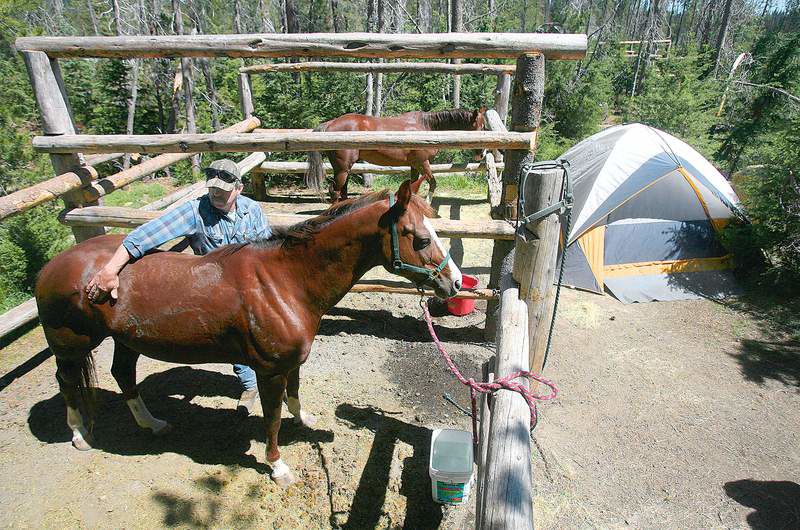Happy campers
Published 5:00 am Friday, August 1, 2008

- Camper Tom Barr from Newport prepares his horse, Boots, for a saddle for his grandson to ride in a stall next to his tent at the Quinn Meadow horse campground near Devils Lake on Thursday afternoon.
Here’s a mathematical equation that some local riders spend their summers proving: Trail riding plus sleeping under the stars equals … bliss.
“We have more horse camps in Central Oregon than in any other part of the state. We are so lucky,” says Kim McCarrel, a Black Butte Ranch resident and author of the book “Riding Central Oregon Horse Trails.”
Trending
Central Oregon is unusual because horse camping is possible for so much of each year. Camp sites in the desert typically are accessible from early spring through late fall. And forested high-country campgrounds provide a cool respite in the hot summer months. This year, however, several high-elevation horse trails are still covered in snow and downed trees.
Pat Marquis, chairman of the local chapter of Oregon Equestrian Trails, moved from Canby to Central Oregon six years ago largely because of all the horse camping opportunities here.
His Paso Fino gelding, Cheyenne, and his wife’s Tennessee Walker, Liz, “gladly get into the trailer when they see us packing up to go camping,” he says. “They get bored being at home, just like we do.”
There are two ways to go camping with horses. Packing involves riding to a new campsite each night — like backpacking on horseback.
Stationary horse camping involves a campsite that serves as a home base. Campers head out for a trail ride each day before returning to the same campsite.
Kate Beardsley, an avid horse camper who lives in Alfalfa, recommends that inexperienced horse campers start by staying at a developed horse camp.
Trending
Central Oregon has dozens of them. Most of the camps in Central Oregon have corrals and a stock water source — a stream or spring — for the horses.
Most also have outhouses and fire rings for the humans. And many have loops of trails that start and end at the camp.
Quinn Meadow Horse Camp, on the Deschutes National Forest west of Bend, between Elk Lake and Devils Lake, is widely considered the crown jewel of Central Oregon horse camps.
“There are 14 rides that you can do either from camp or within a 10- to 15-minute trailer ride from camp,” McCarrel says. “So you could go for a couple of weeks and not repeat any rides.”
Beardsley recommends that more experienced horse campers try packing along the Metolius Windigo Trail — a 140-mile trail from the headwaters of the Metolius River south to Windigo Pass, near Crescent Lake.
“There’s actually a horse camp for almost every day’s travel,” Beardsley says. “So you could ride from the Metolius to Windigo Pass and spend every night but one in a horse camp. … It’s a wonderful front-country experience. You cross the wilderness a couple of times but most of the ride is very accessible. You could actually have friends meet you at a horse camp with supplies and dinner. Or you could leave the horses and go into town to a restaurant.”
Riders who camp in primitive, undeveloped campsites are urged to practice “leave no trace” ethics.
“If people are truly practicing (leave no trace), when they leave, it shouldn’t look like a horse has been there,” Marquis says.
When corrals are not available, Marquis encourages horse campers to tie high lines, or ropes strung between two trees with the horse attached somewhere in the middle.
“It’s safe because the horse is not going to get tangled up in there. And it’s environmentally (responsible) because if the horse does paw a little bit, it probably won’t damage the tree roots,” Marquis explains.
And anytime a rider takes a horse camping, Marquis says the feed should be free of any weed seeds that could contaminate surrounding lands. The Deschutes and Ochoco national forests will soon require that all feed brought onto public lands be certified weed-free.
When they’re not in the saddle, local horse campers are often holding work parties to maintain the trails or spruce up the region’s horse-friendly campsites.
“More than half of the horse camps in Central Oregon have been adopted by either a chapter of Backcountry Horsemen (of Oregon) or a chapter of Oregon Equestrian Trails,” McCarrel says. “They do things like rebuild corrals — so if a log breaks they’ll go up and replace it — and clear out litter and debris and keep the roads graveled.”
The local chapter of Oregon Equestrian Trails, for example, last year adopted the Sisters Cow Camp. The site has historic corrals and sheds that were used since the early 1900s to move cattle over the Cascades. Facing a recent wave of budget cuts, the Forest Service was prepared to shut down the facility. But local riders volunteered thousands of hours to restore the facility and keep it operating.
“If you spend a lot of time trail riding, I think you need to give something back to … keep (the trails and campsites) clear for your fellow equestrians and preserve them for the future,” McCarrel says. “With the Forest Service budget cuts, if the volunteers don’t do it, it doesn’t get done.”








